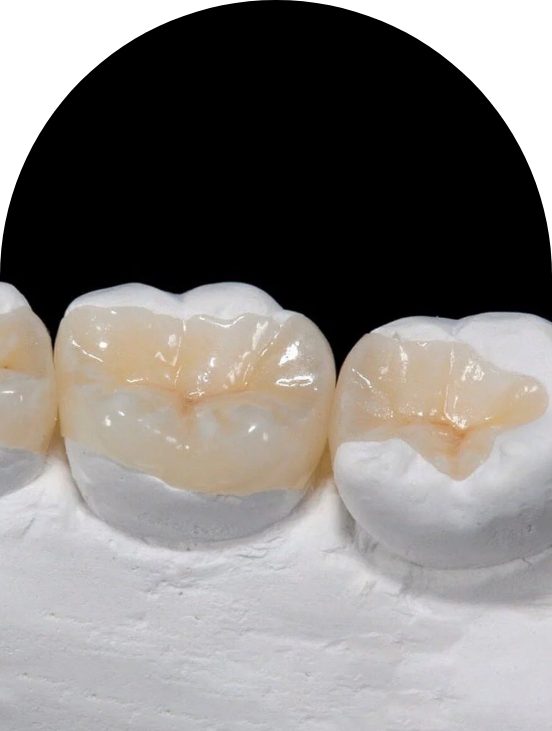Dental Inlays & Onlays in Barrow in Furness
Dental Inlays & Onlays At Barrow Dental Aesthetics

What is Dental Inlays & Onlays Treatment?
Dental Inlays and onlays barrow are restorative treatments which are used when old fillings need to be removed or replaced or as an alternative when it is no longer possible to fit a standard filling because of significant decay or damage to the tooth.
Who is Suitable for Dental Inlays & Onlays Treatment?
Dental Inlays and Onlays in Barrow in Furness are suitable for patients with moderate to severe tooth decay or damage that can’t be properly treated with fillings but don’t need full crowns. They offer durable and custom-fit restoration for damaged teeth.
How do Dental Inlays & Onlays Work?
A dental inlay fills the space in between the cusps – or rounded edges – at the centre of the tooth’s surface. A dental onlay works in the same way but covers one or more cusps or the entire biting surface of the tooth. These conservative dental treatments are minimally invasive – meaning only the decayed area of the tooth is removed. Inlays and onlays fit perfectly into the affected area, meaning decay is less likely to occur once the restoration is completed. Created from special ceramic material, inlays and onlays look and feel just like your natural teeth.
Start your journey
Get an online consultation or visit our clinics.
Call us now
Let's discuss your needs and book you in.
Clinic Address
4 HARTINGTON ST. BARROW-IN- FURNESS. LA14 5SL
Have a question?
Speak with Our Expert Clinicians!
Dental Inlays vs Onlays
Dental Inlays
Dental inlays are restorations which are used to repair teeth with moderate decay or damage within the raised points of the tooth. They are commonly made from materials like porcelain or composite resin and are custom-made to fit exactly within the prepared cavity to provide strength and durability. They also help preserve more of the natural tooth structure as compared to traditional fillings.
Colour
Blends seamlessly with tooth colour to enhance aesthetics
Strength
Provides robust reinforcement, maintaining tooth integrity
Appearance
Offers discreet restoration, preserving tooth aesthetics
Removal
Require minimal tooth removal, preserving healthy structure
Durability
Offer long-lasting durability, withstanding normal biting forces
Allergies
Made from biocompatible materials which are suitable for most patients
Safety
Pose minimal risk, adhering securely to the tooth surface
Dental Onlays
Dental onlays are similar to inlays but are used when the tooth damage or decay spreads to one or more points of the tooth or the whole biting area. They cover a larger portion of the tooth and are designed to convert its shape and function as well as maintain its natural appearance. Both inlays and onlays offer a conservative yet effective solution for restoring teeth with moderate damage.
Colour
Matches tooth colour to ensure a natural appearance
Strength
Offers substantial strength, restoring tooth structure
Appearance
Restore tooth shape & function, maintaining a natural appearance
Removal
Cover more extensive damage, necessitating slightly more tooth preparation
Durability
Provide durable restoration, ensuring longevity and functionality
Allergies
Crafted from hypoallergenic materials which minimise allergic reactions
Safety
Securely bonded to the tooth, ensuring safe restoration
Frequently Asked Questions
Inlays offer more advantages over traditional fillings by preserving a more natural tooth structure and providing a stronger, longer-lasting restoration. They’re often preferred for moderate to severe decay or damage where fillings may not suffice, offering durability and a more precise fit.
In the UK, the cost of inlays and onlays can depend on factors like the material used, the complexity of the procedure, and the dental practice. Generally, they may be more expensive than fillings due to their custom-making.
The cost of inlays reflects the materials used, the actual making process, and the skill of the dentist. Inlays require custom crafting to fit exactly within the tooth and often use high-quality materials like porcelain or composite resin. This customisation and quality can cause higher prices.
Onlays offer a conservative alternative to crowns and preserve a more natural tooth structure while providing strength and protection. They’re preferred for teeth with minor damage where a crown may be overly invasive. Onlays can be a better choice for preserving tooth integrity and aesthetics in particular cases.
Dental inlays and onlays are durable restorations designed to resist normal biting forces. With proper oral hygiene and regular dental check-ups, they can last for many years and provide long-term functionality for the treated tooth.
Like any dental procedure dental inlays and onlays are typically safe and effective but there can be risks of complications such as sensitivity, allergic reactions to materials, or improper fit. However, these risks are minimal when performed by experienced dentists.